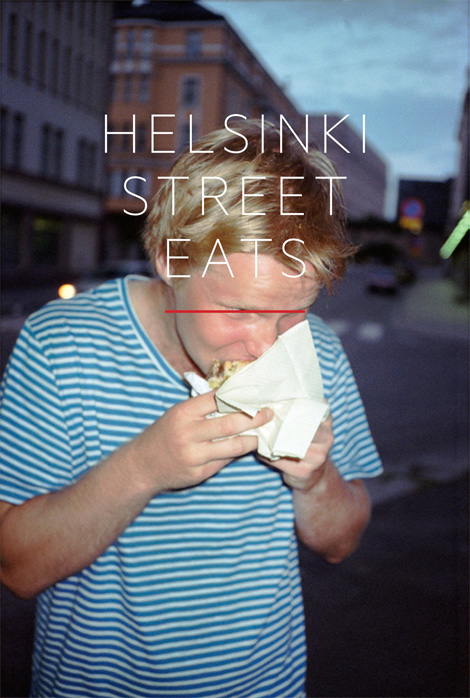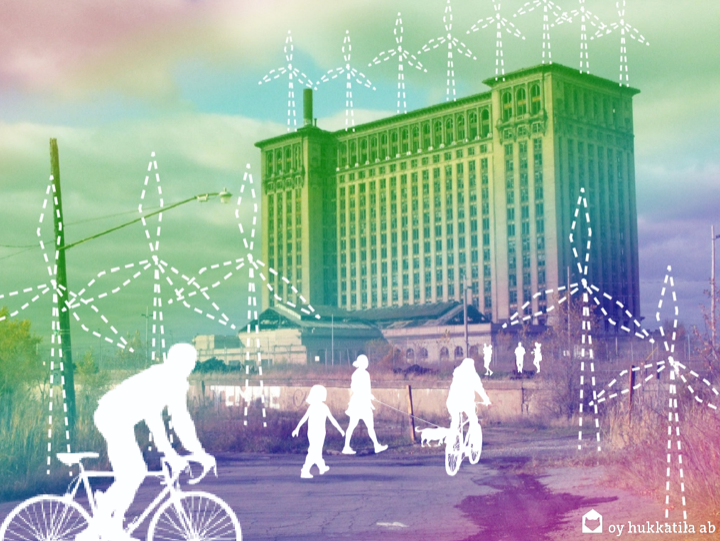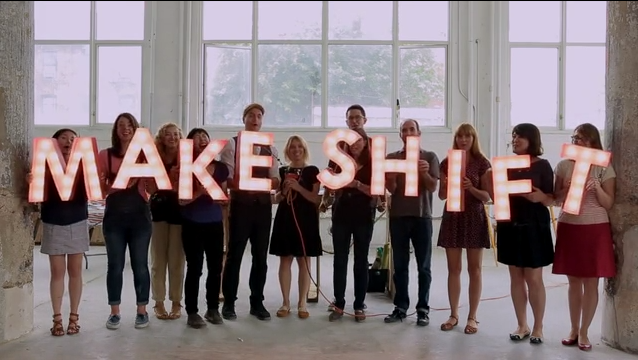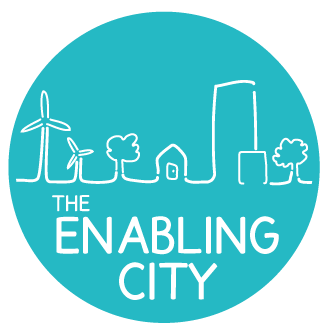by Hillete Warner
Global Innovators is a nine-part series that celebrates the remarkable work of social innovators from outside the English-speaking world. Twice a month we profile the stories of inspiring community pioneers from across three broad cultural clusters: change enthusiasts from Italy, France and the Spanish-speaking world. The series, inspired by the multilingual editions of the Enabling City toolkit, focuses on a rich variety of themes that explore 'enabling' frameworks for participatory social change
Bryan Boyer is an architect and former Strategic Design Lead at The Finnish Innovation Fund (SITRA) in Helsinki, Finland. After a successful and productive time away, Bryan is back in North America working to bring Makeshift Society Brooklyn to life. We spoke with him today about his work in Helsinki, his Kickstarter Campaign for Makeshift Society, and 21st century local decision-making.
Enabling City: Bryan, you are one of the minds behind Brickstarter. Tell us more about the project, what was the idea behind it and what issues you were hoping to address?
Bryan Boyer: Brickstarter was a provocation that asked whether we could use technology more effectively to support civic entrepreneurship. The first spur came from the notion of NIMBYism (Not In My Backyard) and how difficult it is to make bold developments in a city (think public transportation, renewable energy initiatives, or anything that will give shape to our cities in the next century.) We found that the technology is not really the issue (we know how to build a wind turbine)–what it boils down to is coming to the decision that as a community we are ready to accept these kinds of things in our backyard. With Brickstarter, we wanted to move away from NIMBY and toward YIMBY (Yes In My Backyard), so governance around our neighbourhoods and cities was one of the entry points for that.
Entrepreneurship was another one, because as pop-ups seem to demonstrate, more people than ever are interested in changing the city today. In Finland, a pop-up restaurant is treated as separate from the formal life of the city, which means that the administration largely ignores the offering(s) it represents. Helsinki's hugely popular food festival, which happens four times a year, was started when aspiring restauranteurs realized how hard the bureaucratic process of opening a restaurant actually is. From the macro perspective, it would be great if all of the energy that goes into festivals of this kind was applied to making the city have its desired services and cultural experiences rather than just the pop-ups.
The third interest followed a more traditional business perspective. If you’re considering opening a small industrial facility – or, as is now my case – a co-working space, then as a small business you don't have the kind of data about the neighbourhood and its economy to back your decisions. Providing an avenue for the community to express its interests and desires is a way to simultaneously support local economic activity. Brickstarter was an attempt to bridge these three perspectives and provide a platform to understand – and enhance – the interfaces between citizens, communities, and institutions.

Helsinki Street Eats, a book about everyday food published by SITRA
EC: Brickstarter has met with incredible success from the very beginning, though recently the practice of 'urban crowdfunding' has come under close scrutiny. What is your relationship with urban crowdfunding, and how has Brickstarter tried to address some of the pitfalls associated with it.
BB: There is huge potential in crowdfunding the city, but it’s not a straightforward process. We launched Brickstarter at a time when we wanted to add a voice to the discussion and push it out of pure hype. Arguments like “Hey, you can raise $10-million to make a watch on Kickstarter, so let’s just do the same thing for our fire stations or our bike lanes” are simply not realistic.
Brickstarter processes differ from the more conventional crowdfunding of products in five key ways. The first is cost. If we’re talking about crowdfunding a bench, then we could probably find enough people to successfully complete the project. But are we going to crowdfund an 800-million Euro expansion of the subway system? Probably not. Which brings up the next question: Are you paying for the thing in itself, or the planning that goes into it? The sheer cost of urban/infrastructural projects requires a different approach if we care about thoughtful decisions being made.
The second tricky area is opportunity cost. Putting a novel on a crowdfunding site does not prohibit anybody else from doing the same thing. But if you make a proposal for the space on the corner of your block to be a kindergarten, then that space can’t also be a movie theatre. This notion of opportunity costs needs to be something that we think through carefully so that we maintain the type of equitable and well-balanced society that we all want to see.
The third area is catchment. If you’re crowdfunding your watch, then your product can be mailed anywhere in the world. My co-working space will never be mailed anywhere, so the potential pool of people who would contribute is immediately much smaller than the abstract idea of a crowdfunding audience. This is why place-specific, multimillion dollar projects are implausible to fund. On the other hand, if there’s a way to support a richer and more robust decision making process, then that in itself is valuable.
The fourth perspective concerns approvals. Crowdfunding large infrastructure projects is fairly new, which means that there is widespread confusion about the approval process. Aside from reporting and accountability at the city level, this makes it difficult to attach a precise timeline to any given project, which in turn means that it’s very difficult to inform funders about what exactly they are funding and how they are contributing to the project. The scale of these projects is what we think makes Brickstarter unique.
Lastly, there's longevity. If somebody crowdfunds a novel, the worst thing that can happen is that the novel turns out to be bad and nobody reads it again. If we crowdfund a small park, there’s the question of upkeep and of who pays for that. That’s something that hasn't yet been tackled head on in these crowdfunding campaigns. Brickstarter wants to create more awareness and clarity around costs, actors and their roles – considerations that make civic crowdfunding significantly different from product crowdfunding.

Brickstarter
EC: Have you noticed any major obstacles/barriers to the implementation of the "Brickstarter model" in Helsinki or abroad?
BB: We didn’t build Brickstarter entirely on our own because we thought it was important for the city to also be involved. An important consideration is whether those involved have the funds to successfully engage in open-ended development projects (which of course goes hand in hand with changing a City's approvals and decision-making processes.) The founders of Helsinki's food festival quickly realized that their Facebook following was more useful to them than endeavouring to make the hard slog through the paperwork necessary to open a restaurant. They could create this festival and generate the kinds of outcomes they wanted without having to deal with the City's bureaucratic process.
Now more than ever, cities find themselves in the odd position of having to account for unexpected forms of competition. Those who are genuinely interested in finding a way to funnel, attract, or support civically-minded entrepreneurial activity have a unique opportunity. That is what was ultimately at the heart of the Brickstarter project, and something that we held as a requirement for those involved.
EC: What is one unexpected lesson or result that you have learned along the way?
BB: There was a gentleman in Helsinki who had started a public bath. He had a really rough time getting it through approval but kept saying: “the civil servants have been really civil.” What he meant by that is that every time he went to the city to ask for a new permit, the people behind the desk at City Hall were supportive of what he as an individual was trying to do. As an institution, however, the City did not have the capacity to support the small entrepreneur because its bureaucracy had been designed to accommodate the needs of large businesses.
In the industrial era we designed our institutions to be this absolutely uniform, completely regular, exactly the same, dependable service. Today we are finding that more and more people are looking to government to be platform for citizen expression, not a turn-key service.
EC: Brickstarter was part of the Helsinki Design Lab's roster of projects. What other approaches or tools for civic innovation did you explore during your time there?
BB: We looked at everything from new educational platforms to new models of urban development, including low carbon development, civic innovation and welfare. What unfied them all was the design process – everything we took on had a design challenge at its core and had us working in partnership with the local and national governments to solve it.

The Brickstarter book
EC: What is in store for Brickstarter now that the project has officially wrapped up? How can we continue the conversation?
BB: We wrapped everything into a publication because the core team members were moving out of Finland and we wanted to make sure our research was freely available. A great thing about working for the government is that, by nature, the work is in the public domain, so the Brickstarter book is available both as a free download and on-demand. The idea was to spread our ideas in the hopes that someone else will build upon it, or that someone who already has a crowdfunding campaign will take this research and use it as a way to think about their project's next steps.
EC: What are you working on now?
BB: My research interests have evolved into a Brickstarter-type experiment in my new city. I'm working to bring Makeshift Society to Brooklyn. Makeshift was founded by Rena Tom in San Francisco, and we're now in the pre-launch phase of renovating our second space on the East Coast. Despite being one of the largest, most jam-packed cities in America, New York City can still be a lonely place, and a logistically difficult one to navigate. We’re looking at how can we use this co-working space as a platform to support creative entrepreneurs who either want to start or sustain their business. Makeshift is addressing all of their concerns and needs, of which the workspace is only a part. We will also offer classes, skills training, a library full of visual inspiration and business smarts, meeting space, a residency program, and evening events. The San Francisco experience taught us that having a shared workspace is nice, but that there are all sorts of other needs that come into play, some temporary, some ongoing. Access to equipment, for example, is important, so we've made that another part of our mission – and is what we’re hoping to fund through our Kickstarter campaign. The funds raised in this campaign will help us build a creative tool lending library for rental and onsite usage – in other words, the shared, creative resources for making shifts happen.
##
Find Bryan on Twitter, and check out Helsinki Design Lab projects' here. Makeshift's campaign is in its final week, click here to back the project or learn more about the space.









